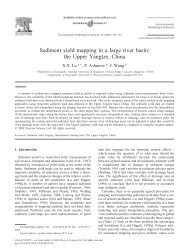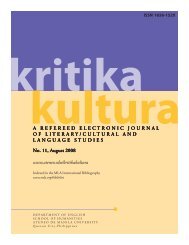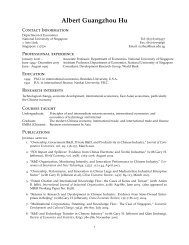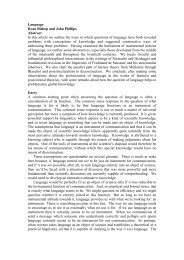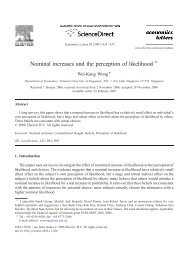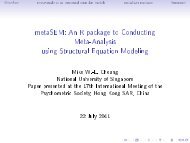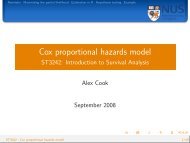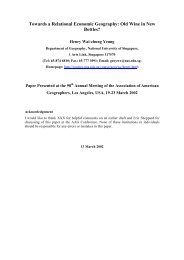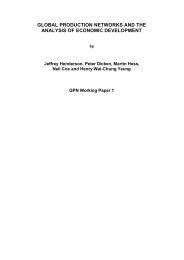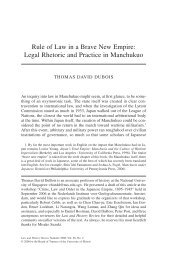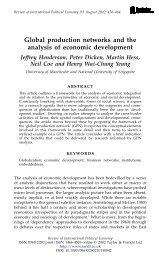The aggregate consumption puzzle in Singapore
The aggregate consumption puzzle in Singapore
The aggregate consumption puzzle in Singapore
Create successful ePaper yourself
Turn your PDF publications into a flip-book with our unique Google optimized e-Paper software.
564 T. Abeys<strong>in</strong>ghe, K.M. Choy / Journal of Asian Economics 15 (2004) 563–578<br />
Fig. 1. <strong>The</strong> APC <strong>in</strong> S<strong>in</strong>gapore.<br />
<strong>consumption</strong> functions for S<strong>in</strong>gapore have obta<strong>in</strong>ed elasticities that are well below one,<br />
thus implicitly allow<strong>in</strong>g the APC to fall as <strong>in</strong>come <strong>in</strong>creases 2 (Lim & Associates, 1988,<br />
Chapter 16; Toh & Ramstetter, 1994; Wong, 1974).<br />
When the APC is measured as the ratio of real private <strong>consumption</strong> expenditures to real<br />
GDP <strong>in</strong> S<strong>in</strong>gapore, it has <strong>in</strong>deed fallen steadily over time from 0.80 <strong>in</strong> 1960 to 0.42 <strong>in</strong> 2003<br />
(Fig. 1). This has produced the lowest share of private <strong>consumption</strong> <strong>in</strong> output <strong>in</strong> the free<br />
world. Even amongst the former centrally planned economies, Ermisch and Huff (1999)<br />
noted that the lowest share of private <strong>consumption</strong> reached <strong>in</strong> the Soviet Union was 55%.<br />
<strong>The</strong> dramatic decl<strong>in</strong>e <strong>in</strong> the APC seems to have left the S<strong>in</strong>gapore economy without a<br />
dependable built-<strong>in</strong> stabilizer, which together with the higher volatility of external demand<br />
could have contributed to the <strong>in</strong>creased amplitudes of S<strong>in</strong>gapore’s bus<strong>in</strong>ess cycles <strong>in</strong> recent<br />
years.<br />
<strong>The</strong> long-term decl<strong>in</strong>e <strong>in</strong> the APC is puzzl<strong>in</strong>g and anomalous because s<strong>in</strong>ce Kuznets’<br />
(1946) pioneer<strong>in</strong>g work, it was observed that the APC is relatively stable <strong>in</strong> the long run.<br />
<strong>The</strong> post-war evidence on selected economies bear out this remarkable fact: Table 1 shows<br />
that the shares of private <strong>consumption</strong> <strong>in</strong> GDP of the United States and United K<strong>in</strong>gdom<br />
have hovered around two-thirds to three-quarters from 1960 to 2000. In Asia, Japan saw its<br />
APC fall dur<strong>in</strong>g the 1960s and 1970s—probably a reflection of the demographic transition—but<br />
the ratio has stabilized s<strong>in</strong>ce 1980; this trend was mimicked by Taiwan and Hong<br />
Kong. Switzerland, a mature <strong>in</strong>dustrialized economy, is perhaps the best comparison for<br />
S<strong>in</strong>gapore <strong>in</strong> view of its smallness and openness. As S<strong>in</strong>gapore reaches a stage of<br />
development that is comparable to Switzerland’s, one would expect its APC to stabilize.<br />
This, however, has not happened thus far.<br />
Historically, the life-cycle and permanent <strong>in</strong>come hypotheses were formulated precisely<br />
to expla<strong>in</strong> the stylized fact of a constant APC, as the simple Keynesian <strong>consumption</strong><br />
2 a 1 a Given the simple <strong>consumption</strong> function C ¼ AY , the APC is C=Y ¼ Að1=Y Þ.If0< a < 1, the APC will<br />
fall as <strong>in</strong>come rises.



